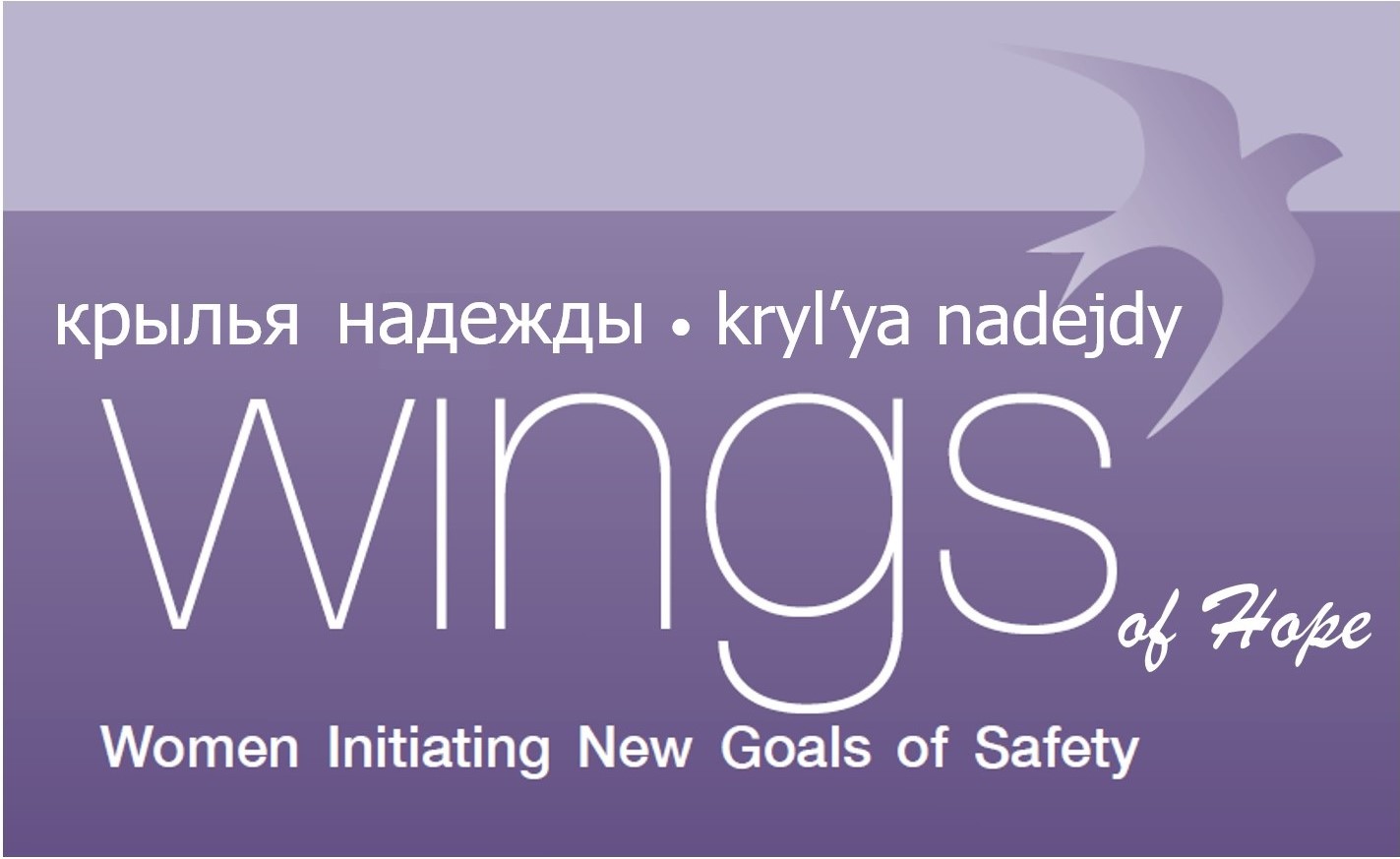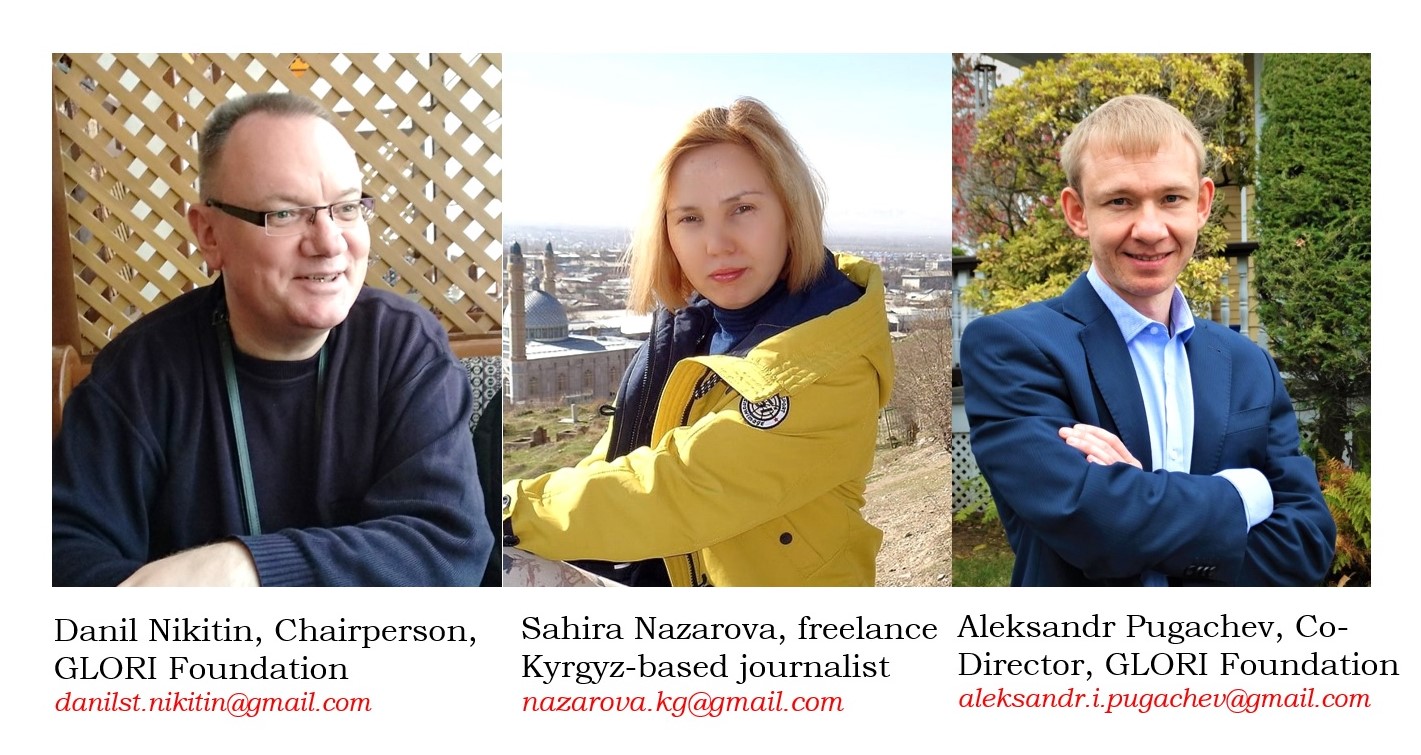
Sahira Nazarova, the Kyrgyz-based journalist, has interviewed Danil Nikitin and Aleksandr Pugachev of GLORI Foundation who told of their experience with the WINGS of Hope project, findings, and next steps. This unique project has been designed for women who use drugs, those who experience multiple life-impacting issues including missing profession, lack of employment and means for living, break up of relative relations and social ties, low legal literacy, low self-esteem, and a lot of mistrust of other people and society in general. The only resource for them is community-based women-servicing organizations, which apply a peer-to-peer approach and since recently have opportunity to offer their beneficiaries the unique services that are described below.
Sahira Nazarova: The WINGS of Hope project is recognized globally as a unique project initially implemented in Kyrgyzstan by a group of activists and researchers. Tell us briefly about the implementers.
Danil Nikitin: In Kyrgyzstan, the Global Research Institute (GLORI) Foundation, in collaboration with the local NGO partner organizations “Asteria”, “Podruga”, “Positive Dialogue”, “Plus Center”, “Sotsium” and “Chance” successfully implemented the WINGS of Hope project in 2013, 2014 and 2016. For three years of implementation, the project provided services to 213 women who use drugs, provide sex services, who are vulnerable to violence and whose specific needs are continually ignored. The renowned researchers from Columbia University Social Intervention Group – Louisa Gilbert, Timothy Hunt and Tina Jiwatram-Negron – were involved in the project and dedicated a lot of time, effort, and expertise to successfully implement this project.
Sahira Nazarova: How did you come up with the name “WINGS of Hope” for the project?
Aleksandr Pugachev: The project name actually was proposed by participants. Early on, a focus group in the south Kyrgyzstan (2013) was held with sex workers from a Karasu sauna and this is where the idea for the name came up. The English abbreviation of WINGS stands for Women Initiating New Goals for Safety. The name stuck because among the other things, our team was also dealing with finding the option which would have no hint to gender violence. This was important from the point of safety for project participants and staff.
SN: What does the WINGS model look like?
DN: The key components of WINGS model include: a short educational course, where women are trained about the specifics of particular type of gender-based violence; a screening process to identifying the level of victimization with the purpose to find out about the risk of becoming the victim of violence; intervention aimed at, motivating and improving the participant’s emotional state, developing the safety plan; and referral to appropriate service-providers, setting goals for the nearest future, and providing opportunity for HIV test with gender-specific counselling. This approach is called SBIRT, which stands for Screening, Brief Intervention, and Referral to Treatment.
All components are equally important, all require great attention, and are presented in a specific sequence to maximize support and results. Let us look at, for example, the first component, which is a short educational course through which woman during the individual sessions with our facilitators gets introduced to definitions and overview of violence and its types, and how they are different from each other. This key element is followed by screening the women participants. The unique screening helps to identify the level of victimization. While raising women’s awareness regarding violence, facilitators engage them in discussing of and agreeing on terms, concepts, and vocabulary to be used throughout the intervention sessions. This approach proved to have impact on achieving the positive results.
Intervention session looks like a ladder. Every brick in this ladder is unique and has its place and purpose. For example, the goals set by one woman will not work for another. One participant decided that the solution to the problem would be to attend a course of self-defense, another turned more to religion, while others started looking for job in order to have a sustainable income. For many, the priority was to restore relationships with family members and friends that were lost in the everyday troubles and during incarceration. Fortunately, none of the participants decided to leave “things as they are” and decided to make positive change something in their life as far as in relationships with partner or society.
The same applies to the safety plan. It is not just a brick in our ladder; this is one of the cornerstones on which everything rests. Preparation and thorough plan development helps to ensure that a participant knows where and who to call in case of danger, where to hide in case of violence, and how to behave and what to do for preventing violence or minimizing its harm for herself and her loved ones. The safety plans are very important — it is important to remember that more than 70% of women, who participated in the project had children and more than half of children under the age of 18 years.
AP: The next critical step in the WINGS of Hope is to provide women with a unique scope of services which may increase their safety and their personal and social abilities. Considering their history of abuse, women who have experienced gender-based or intimate partner violence, have specific and more complex needs. They can hardly benefit from standard legal and health programs available for mainstream groups.
We call this ladder “behavioral intervention”, it is built brick by brick during two individual sessions with a break of 7 to10 days. This is our “WINGS of Hope” program, based on SBIRT principles, proposed by researchers at Columbia University in the City of New York and then adapted to our context.
SN: What makes the women participants vulnerable?
AP: Our project aims at those who cannot get treatment or stop using right away or are under the burden of problems rooted in younger years. The participants in this project have wide-ranging but life-impacting issues including having lost personal identification documents, e.g., birth certificates, that jeopardizes access to health services to themselves and their children.
SN: How much existing crisis centers help women who use drugs?
DN: There are only few of them in Osh and Bishkek, however, only small percent of existing crisis centers have professional staff that possess necessary knowledge and experience working with women who use drugs. This problem is not only here in Kyrgyzstan. Similar situations exist in more developed and wealthy countries including in Europe and United States. Often, crisis centers and shelters in communities are rare, regardless of which country we are talking about. This is why it is important to develop a reliable network of partner agencies that would include drop-in centers and shelters and function as a coalition of the trusted community-based service providers involved in referrals. In the WINGS of Hope project, crisis centers and networks of grass-root organizations are involved in collaboration between police, other officers of the justice sector, and health and social service providers.
SN: What are the project outcomes?
AP: The WINGS of Hope outcomes show that women who use drugs and women engaged in sex trading are very vulnerable to violence. Violence against these groups is systemic and perpetrated by individuals and some government agencies’ staff, including police (whose primary mission should be the protection of their rights and providing them with services regardless to their background, behavioral specifics and other factors). Violence by law enforcement officers is one of the reasons for the mistrust of women towards state officials and their unwillingness to appeal for police help in case of violence. Thus, only 8% of the project participants in 2013, 2% in 2014, and 6% in 2016 called police after they experienced episodes of violence that they consider the most traumatic, severe, and that affected them the most.
While analyzing the accumulated data of violence episodes over 3 years of project implementation, we discovered that police officers were reported as perpetrators by 15% of the project participants. In the stories of police violence that participants shared with intervention facilitators, women mentioned episodes of verbal abuse, money extortion, unlawful detention, intimidation, blackmailing, beating and other illegal actions. In their stories, the women described the experiences as “lawlessness”, “forced strip off”, “chained with handcuffs to the heater and left unattended for the whole day”, “forced me to strip and walk naked”, “offended using dirty words”, and “threatened to create podstava [accusation based on fake testimonies]”.
Women participants stated that they experienced violence also from husbands, partners, co-habitants, and ex-spouses. The most common type of abuse was psychological abuse in the form of insults and threats. Other experienced forms of violence included twisting their arms, or throwing something at them, threats of murder, insisting on having sex even they didn’t want to, forcing to have sex without a condom, forcing to provide sexual services, preventing from seeing family, and forcing to eat by herself, away from family.
DN: Looking at the statistics in the project report, people will better understand why there is a critical need for structural and community level interventions to redress gender-based violence among these key affected populations of women. Only 12% of 213 WINGS of Hope project participants, i.e. women who use drugs and women engaged in sex trading, reported that had never experienced either IPV or GBV (graph 01):
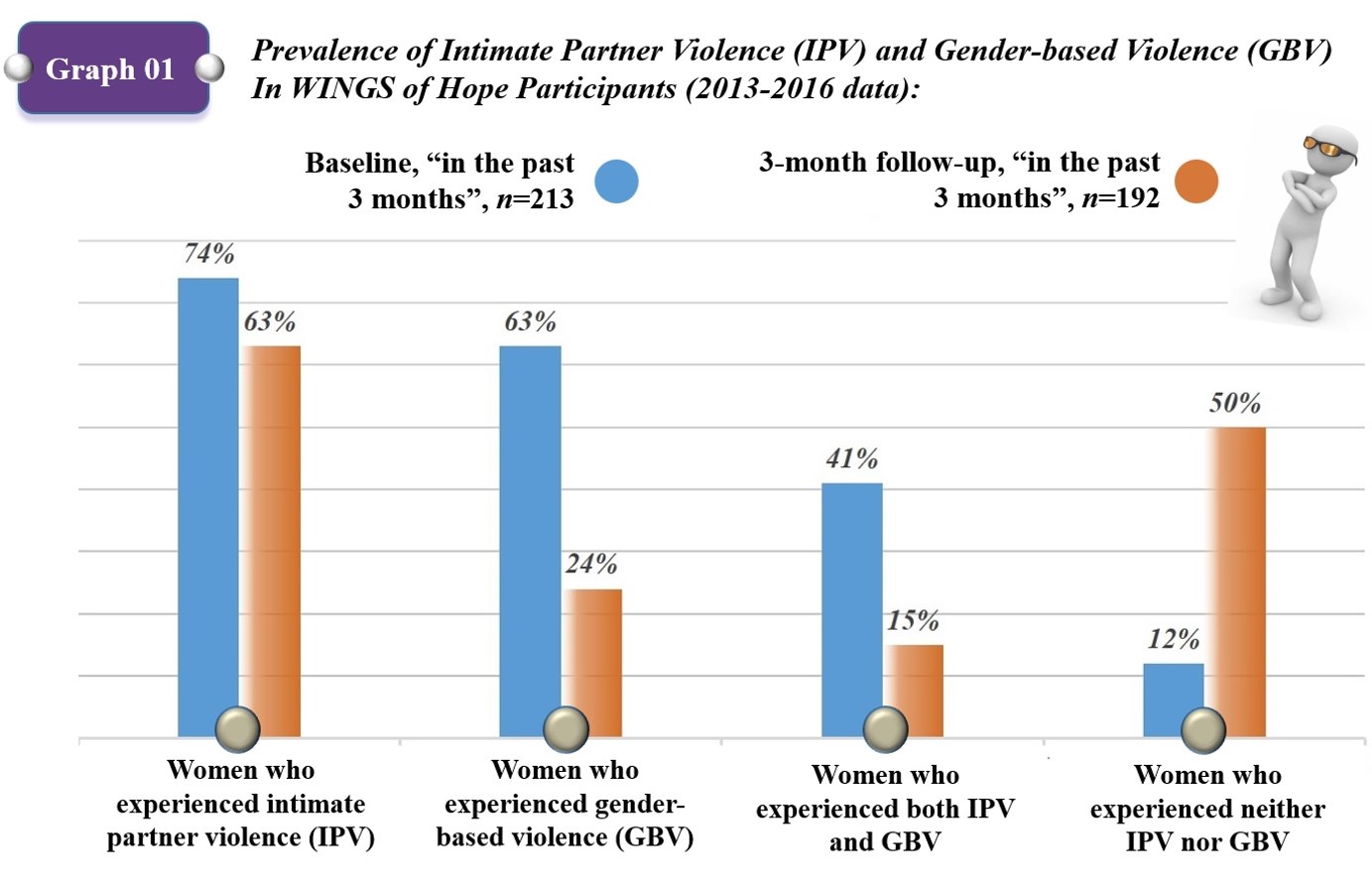
15% of the WINGS of Hope participants experienced violence from police staff, and 37% of police staff who took part in trainings arranged for them as a part of WINGS of Hope, thought that women who use drugs and abuse on alcohol, deserve being humiliated and violated. Additionally, 53% of police staff who took part in trainings arranged for them as a part of WINGS of Hope thought that a man using violence against his wife is a private matter that shouldn’t be discussed outside the couple. Only 6% of women who use drugs and women engaged in sex trading, who participated in the 3-year WINGS of Hope project, applied for police help after experiencing violence and only 18% of the 213 WINGS of Hope participants applied to a medical professional help after the episodes of violence (graph 02):
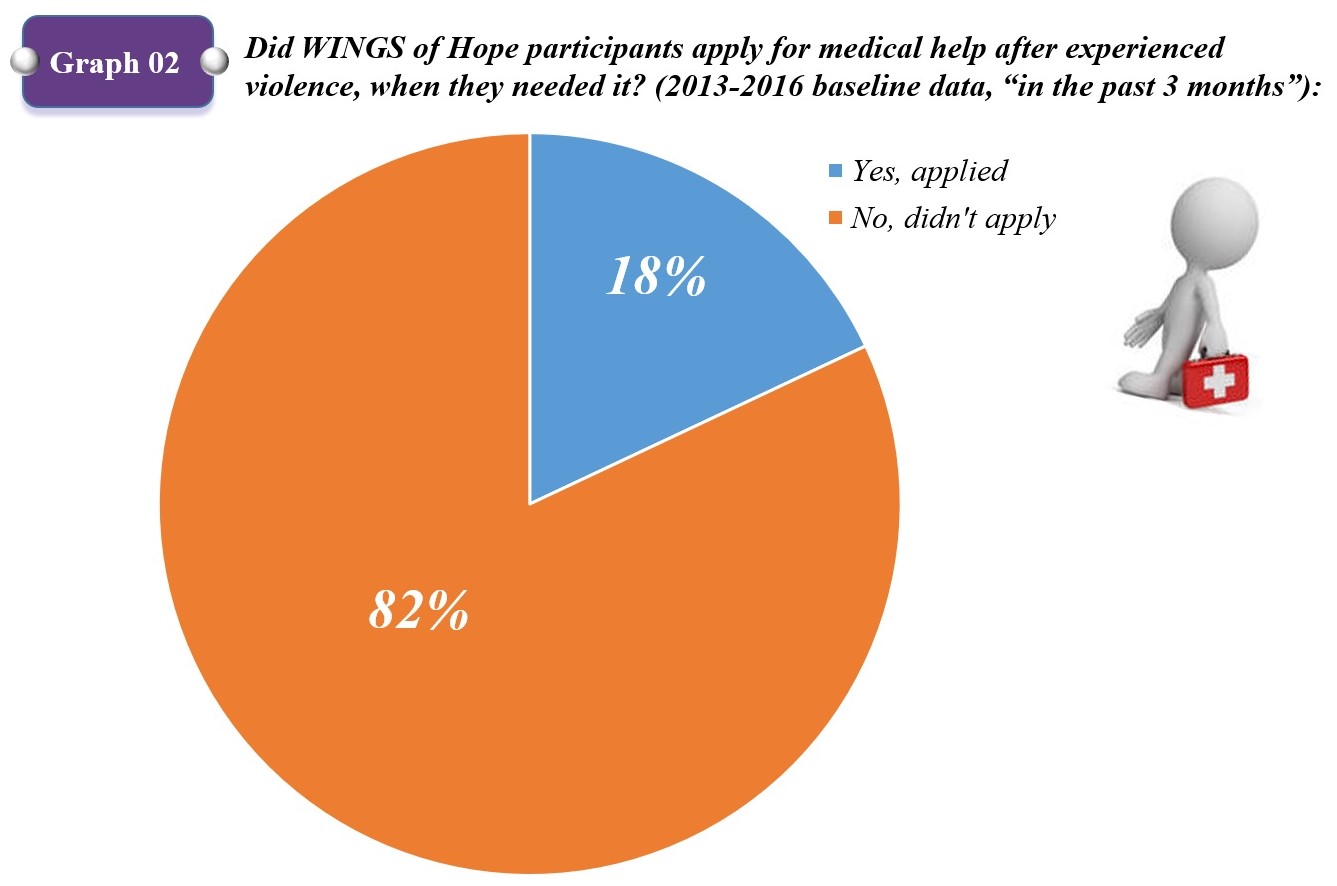
In the study, 45% of the participants reported that the main reason why they don’t disclose episodes of violence and don’t ask for help, is feeling embarrassed about it, and 39% of the WINGS of Hope participants reported having been exposed to traumatic experiences, including sexual harassment and violence, before the age of 17. Finally, 46% of the WINGS of Hope women participants (n=213) confirmed they had experienced overdose and stated that they knew approximately 465 people who experienced overdose in the past 3 months (graph 03):
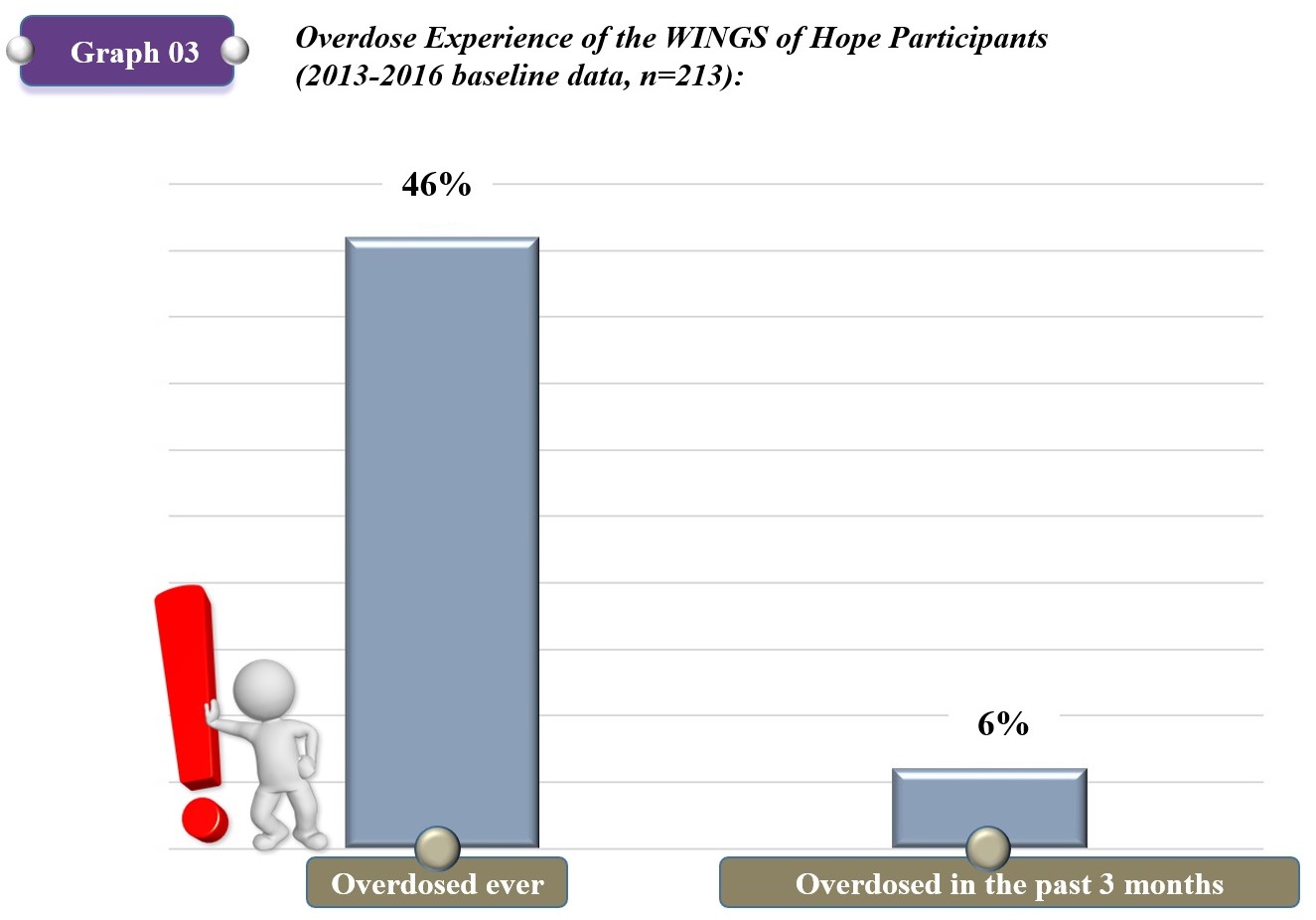
SN: How do WINGS intervention sessions help these women?
DN: Look at Graph 01 — do you see the two bars, blue and brown? After attending individual intervention sessions and motivational interviews, according to the 3-month follow-up survey, participants experienced significantly fewer intimate partner and gender-based violence incidents of any kind, including severe and minor physical, severe and minor sexual, verbal and psychological incidents than what they had experienced at baseline. Participants also reported significant reductions in illicit and injection drug use, ability to create and maintain safer sex trading context, as well as increased access to GBV-related services. There is no doubt that the project “WINGS of Hope” improves the condition of women participating in it.
There is no magic wand to make all dreams come true but dedicated programs with reasonable, realistic and measurable efforts that assume hard work focusing on beneficiaries’ and staff members’ safety and wellbeing enhancement, the way that is full of success and disillusions. What we do know is that if a woman comes to the project and is committed to participating it is a first step toward reducing the scope of violence in her life.
Our facilitators collaborate with participants and share information with respect and without judgement. The goal is to support women and encourage them to come up with an idea or a solution that would make the most sense to her and reflect her own experiences.
One of the women participants using the services of the project “WINGS of Hope” through the Osh-based Positive Dialogue Foundation, shared self-written verses:
Why came I into this world?
Who pulled me by my wrist?
Dark spirit reigns over all,
And people act like beasts…
AP: Only if intervention is based on professionalism, sense of empathy, activism, and commitment to help, will we be able to help people such as the author of the dramatic verses.
SN: Will the WINGS of Hope be continued in Kyrgyzstan? Is there funding for it?
DN: The current funding stream for WINGS of Hope has ended. However, the AFEW – Kyrgyzstan Foundation was able to secure funds for integrating the key elements of the WINGS intervention into their projects that they run collaboratively with Asteria Foundation and Podruga Foundation. We are very grateful to Natalia Shumskaya, the head of AFEW – Kyrgyzstan, and her team for their hard work and support.
We will continue to work with donors to try to identify available funding to continue the project or with the government to integrate these types of services into regular care. There are many competing needs particularly in a resource-strained country such as Kyrgyzstan, but we strongly believe in the need for such program for a greatly underserviced population. We understand however that the interests and priorities of the donors are changeable, and their support mostly depends on the state of world economy, political situation as well as many other factors.
SN: Now we know that the acronym WINGS means, Women Initiating New Goals for Safety. But what about hope?
DN: For us, the implementers, the second part, “Hope”, is of great importance. Hope for what? Hope against what? Hope shared by whom? Hope as something virtual, like a dream, or as an expectation of a certain outcome, like a plan? Let’s “blend” the concepts of “hope”, “desire”, “expectation” and “wish” – here you go, this mixture now perfectly describes what we felt years ago when decided to apply the WINGS model in Kyrgyzstan. We were motivated by a dream of a greater and safer environment where people can be vocal and still not imprisoned. By a dream of a tolerant society where people can be different with lesser risk of being beaten by majority. By a dream of a transparent and accountable government that would be willing and able to work collaboratively with diverse communities. In Kyrgyzstan, we know there is still a lot of work to be done as civil activists continue to report cases of violations of human rights, abuse by police, and insufficient access to justice, legal and health services caused by corrupted officials.
AP: So, we will keep promoting the WINGS model to other countries, in the region and beyond, as a relevant tool not just for preventing gender-based violence and helping its survivors, but also as a platform for locating and uniting professionals and civil activists who are interested in making the world around more open, more transparent, and fairer. As Robert Penn Warren mentioned, we’ll keep making goodness out of badness, because there isn’t anything else to make it out of.
Interview by Sahira Nazarova


















